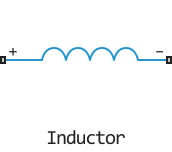Inductor (Advanced)
An inductance coil that accounts for inductance error.
blockType: AcausalElectricPowerSystems.Passive.Inductor
|
Path in the library: |
Description
The Inductor block allows the modelling of linear inductance coils, accounting for inductance error.
When the inductance error is not taken into account, the behaviour of the component is identical to the block Inductor.
In its simplest form, the Inductor block models a linear inductance coil described by the following equation:
Where:
-
- voltage;
-
- inductance;
-
- current;
-
- time.
To model a nonlinear inductance coil, use the block Nonlinear Inductor.
Errors
You can add an error to the nominal value of the Inductance parameter. This error is usually specified in the data sheets. The table shows how the unit applies the error and calculates the inductance depending on the selected Tolerance application.
| Tolerance application parameter value | Inductance value |
|---|---|
|
|
|
Uniform distribution: Normal distribution: |
|
|
|
|
In the table:
|
|
Parameters
Main
Inductance - nominal value of inductance
1e-6 Gn (by default) | positive | scalar
Nominal value of inductance. The inductance value must be greater than zero.
Tolerance (%) - inductance error
20 (By default)
The inductance error specified in the manufacturer’s data sheet.
Tolerance application - method of applying the error in modelling
None - use nominal value (by default) | Random tolerance | Apply maximum tolerance value | Apply minimum tolerance value.
Select how the error is applied during modelling:
None - use nominal value - unit does not apply tolerance, uses nominal value of inductance.
Random tolerance - the block applies a random offset to the inductance value within the error. You can choose uniform distribution or Gaussian distribution to calculate the random number using the Tolerance distribution parameter.
Apply maximum tolerance value - the inductance is increased by the specified tolerance value.
Apply minimum tolerance value - the inductance is decreased by the specified error value.
Tolerance distribution - type of tolerance distribution
Uniform (By default) | Gaussian - type of error distribution
Select the distribution type for the tolerance:
-
Uniform- uniform distribution. -
Gaussian- normal distribution.
Dependencies
To use this parameter, set the Tolerance application parameter to Random tolerance.
Number of standard deviations for quoted tolerance - used to calculate normally distributed random numbers
4 (By default).
Number of standard deviations for calculating normally distributed random numbers.
Dependencies
To use this parameter, set the Tolerance distribution parameter to Gaussian.
Series resistance - series resistance
`0 (By default)
The equivalent series resistance (ESR) of an inductance coil, which is sometimes listed on manufacturers' data sheets. By default the value corresponds to the unit Inductor.
Parallel conductance - parallel conductance
1e-9 1/ohm (by default)
Parallel conductance associated with an inductance coil. Modelling some circuits may require a small parallel conductance. You can also use this parameter to model losses in the core of an inductance coil.
